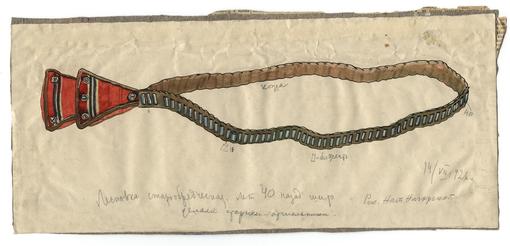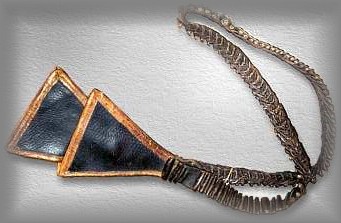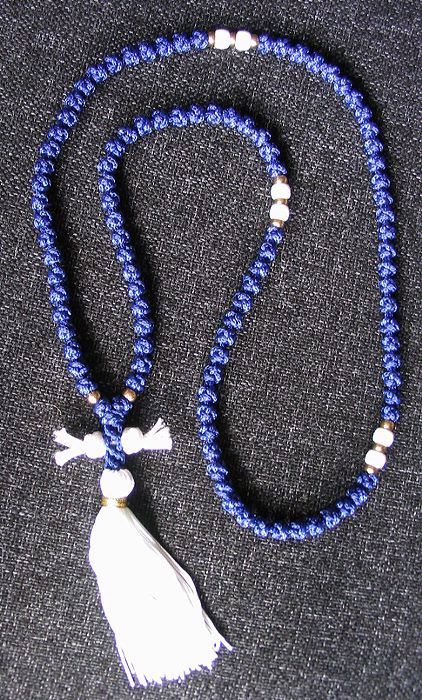| MUSEUM
Antique Rosaries |
HISTORY
of the Rosary |
for you index |
cord instructions |
LINKS |
EMAIL
US+
877.695.3561 |

LESTOVKA |
|
PRAYER COUNTERS Throughout history, Christian and non-Christian religions alike have used different forms of prayer counters with which to repeat shorter invocations many times each day. Christians of both Western and Eastern Rite traditions have a long acquaintance with such counters or prayer beads. + But what are the differences in their use that are to be found between East and West and how do prayer beads come to play such an important role in the spiritual life of both traditions? for more information or return to
|
|
*PRAYER BEADS* By Alexander Roman PHD |
|
OF COUNTING PRAYERS At the outset, it is important to note that the early Christians used various means of counting prayers. St. Paul of Thebes, for example, used to have a bag with three hundred pebbles and placed one pebble for each of the prayers he said into another, empty bag. This was also how the sister of St. Francis of Assisi, St. Clare, prayed. + PRAYER STICKS AND STAFF NOTCHES In Christian Ethiopia prayer sticks were devised and notches were made on staffs used as supports for people standing during the long services. Forty-one notches were made since the prayer, "Lord have mercy" is repeated forty-one times in honour of the forty-one lashes the Coptic tradition believes Christ received during His Passion. Elsewhere, pieces of wood were attached to strings and then knotted cords were devised. + THE 'ROSARY' AND 'GARLAND OF ROSES' It was the Western, Celtic and Sarum Rites that were to develop what is today known as the " Rosary" or " garland of roses." The Western Churches, like those of the East, had a great devotion to the Psalter of David which they divided into three parts composed of fifty psalms each. The " three fifties" were recited for the dead and for all manner of other intentions as well by both monastics and lay-people. There were even prescribed numbers of times that the Psalter was to be recited. For example, for a deceased bishop in England, the Psalter was to be said by monks no less than 600 times! When a lay-person died, the Psalter was said over the body immediately and then individuals would take turns reciting it a further four times throughout the night. St. Patrick and other Celtic Saints would recite the first "fifty" and then stand in cold water to recite the next - this to keep alert and awake. + LITTLE PSALTERS AND THE LORDS PRAYER To accommodate monks and lay-people who could not read, little psalters were devised based on the repetition of the Lord's Prayer and the Angelical Salutation 150 times, divided into three fifties. Other psalters based on meditations on the life of Christ and the Most Holy Mother of God were also developed. Soon these were all fused into "Our Lady's Psalter" or the "Rosary," where 15 Our Fathers and 150 Hail Marys were prayed along with meditation on Gospel themes. The use of the Rosary is of a venerable age and the Western Rites of the Orthodox Church continue in its use. It was and continues to be in use among the Eastern Catholic Churches, although its adoption has sometimes been called a result of "Latinization." + ALWAYS PRIVATE NEVER PUBLIC SERVICES The fact of the matter is, however, that the Eastern Orthodox Church has and still does use similar prayer forms which are always private practices of the faithful and never public services as they are in the Roman Catholic West. + Orthodox monastic manuals prescribe the recitation of up to 150 Our Fathers and the same number of Hail Marys, accompanied by prostrations at the end of each prayer. The famous Saint Seraphim of Sarov had his special devotion of walking around the perimeter of the Monastery of Diveyevo, reciting the 150 Our Fathers and 150 Hail Marys for all one's relatives and acquaintainces, living and dead. At the end, the person was to ask for one special grace- and it would be granted on condition that the person truly needed it. + THE WESTERN ROSARY The use of a form of the Roman Catholic Rosary was in vogue among Eastern Orthodox bishops, including meditation on the mysteries. Such forms of prayer are to be found among the devotions of representatives of the Kyivan Baroque spiritual period in the eighteenth century, including St. Dimitry Tuptalo who translated the "Lives of Saints" into contemporary language and who even adopted western prayer forms in honour of the "Joys and Sorrows of Our Lady" and the practice of reciting a "Hail Mary" at the beginning of each and every hour of the day. + Thus, the Western Rosary was used solely as a substitute for the Psalter which it reflected in nature. The Eastern "chotki" or "vervitsa" was for a different purpose altogether. + PRAY ALWAYS Monks in the Coptic and Palestinian deserts developed intense, personal prayer lives where they repeated short prayers to God throughout the day, in response to the Gospel injunction to " pray always." Soon, a prayer developed that invoked the Name of the Lord Jesus and united it with a petition for mercy- "Lord Jesus Christ, Son of God, have mercy on me, a sinner." Forms of this prayer were used by monks to develop the Prayer of the Heart, constant spiritual watchfulness and to implore the anointing of the Holy Spirit as a healing balm over the human spirit and soul, weakened and darkened by the Sin of Adam. + WAY OF THE PILGRIM AND THE JESUS PRAYER Prayer ropes consisting of 100 to 300 knots or beads were employed to keep track of one's counting, since it was believed that this prayer must cleave to the lips, heart and mind of people through constant, incessant repetition. Monks often recited the prayer up to 12,000 times per day, until the prayer became "self-active" and they would pray it day and night. The famous book, "Way of the Pilgrim" is a good introduction to this form of prayer, along with the Philokalia, a collection of Patristic wisdom about the spiritual life and the Jesus Prayer. Greek monks often made what they call, " martyria", or leather strings attached to the prayer rope with moveable beads to keep track of the hundreds of times the prayer is recited. + Again, the Psalter as a model for prayer was reflected in the structure of the Prayer of Jesus. The Fathers of the Church, especially in Jerusalem, divided the Psalter into twenty "kathismata" each containing three shorter units ended with the longer doxology: Glory be to the Father . . . Alleluia, Alleluia, Alleluia, Glory to you, O God (3 times), Lord have mercy (3 times) and Glory be to the Father.... The Jesus Prayer could substitute the Psalter by saying 300 prayers for each kathisma. Similarly, the Jesus Prayer could substitute for the Chasoslov by reciting it up to 1,000 times with prostrations. + WOOLEN PRAYER ROPES CHOTKI TO THE LADDER 'VERVISA' In addition to the woollen prayer rope or "chotki" the Slavs devised a leather prayer counter with steps or ladders which was called the "vervitsa" or "step-ladder" (to heaven). To this day, monks of the East are given the chotki or vervitsa during their monastic profession. They and Eastern nuns where them on their left hand as a reminder to "pray always." It is from this device that the later Roman Catholic Rosary was developed. Larger knots separate the smaller ones on the Eastern vervitsa every twenty-five or ten knots. When it is separated every ten knots, this is to indicate a prostration to the ground every ten prayers. Arab Orthodox and Eastern Catholics use prayer beads divided every 33 beads. This device is also used by Muslims, and evidence is strong that the Muslims took this from the Christians, and not the other way around. + SPRINGS OF WATER WILL FLOW WITHIN YOU The use of the vervitsa in reciting the Jesus Prayer and other prayers is a tremendous spiritual help to all Christians. It allows one to maintain concentration and recollection during prayer time. Repeating the same prayer over and over is not tedious, if we remember that the words of the Jesus Prayer are like a deep stream of cold, refreshing spiritual water. We need to drink many times from it to quench our spi ritual thirst and to develop into spiritually strong persons, until, as our Saviour said to the Samaritan Woman at the well, "Springs of water will flow within you." + MAY WE ALL BECOME SUCH MISSIONARIES Let us use the vervitsa to frequently invoke the Name of Jesus, the "Epiclesis of our Lord," as the Fathers call it, to call down the Holy Oil of Divine Mercy on our hearts and souls, that Oil that heals our inner person and transforms us. This is a devotion that will last our entire lives, an undertaking that we do in imitation of the ten wise virgins, who came to their Master with abundant oil in their lamps. Let us pray that we become like those lamps, alight with the fire of the Holy Spirit and strengthened in the Name of our Lord, to perform good works all our lives, so that those seeing our light and our works, will turn to praise God our Father in Heaven. As St. Seraphim once said, "Acquire the spirit of peace, and a thousand souls will be converted around you!" May we all become such missionaries! |
|
*KNOTS, BEADS, COUNTS* |
|
AROUND THE WORLD There is little that I find more exciting than rosaries and prayer-beads. I have one from Asia that has 108 beads and also has two strings with ten beads each that one uses to count the number of hundreds. I use to repeat the Jesus Prayer and carry it with me everywhere, since you never know when you can steal some moments of time and do something really meaningful like pray. + FROM CHRISTIANS TO MUSLIMS? My next door neighbour is Arab Orthodox and he has a Muslim set of 33 prayer beads. He insists the Muslims got it from the Christians. When I was in Hawaii, I visited a Buddhist temple and met with their bishop-leader. A very nice man, I told him about how the story of the Buddha got into the Christian calendar by accident and how, until recently, November 27 contained the name of "St. Joasaph of India" who was actually the Buddha! He wrote all that down for his next sermon and then gave me their rosary which consists of two circles of beads that are interconnected with one another. Apparently, you hold down one bead on one rosary while you go around the other rosary. And so one may keep count of up to over 35,000 prayers! + 'CLIMB WITH YOUR THUMB' The Eastern Church (of which I am a member) uses woollen rosaries with 33, 50, 100, 150 and 300 knots made in a similar way to your knotted rosaries. I have one and I also have a leather rosary from Russia which is made up of 109 leather steps that you "climb" with your thumb as you go around saying the Jesus Prayer. It is divided into: 12 steps for the 12 Apostles, 17 steps for the 17 prophets (including John the Baptist) 33 steps for the years Our Lord lived on earth and 38 for the weeks and days Our Lord was in the Virgin Mary's womb. There are nine larger steps signifying the choirs of angels and four triangular sides at the bottom representing the evangelists. Quite a nice thing! + The Celts' rosary was of 150 knots or beads since they recited the Psalter every day. |
|
I am from Toronto, Ontario, Canada and have had a life-long interest in prayer-beads and theology. In the days of Soviet Communism, I used to work with my aunt in sewing rosaries and other devotionals into the coats and jackets of clothing donations to people in Eastern Europe. The nuns would also write us back to let us know they received the items using the code term, "We love your special gifts to us." I am currently writing a catechism on saints to be used in Eastern Europe. + My Great Uncle was an Underground Catholic Archbishop who spent ten years in Siberia. His name was Volodymyr Sterniuk of Western Ukraine. He always had a rosary in his hand and this is, I am sure, how he got through it all For the Glory of God and the Honour of His Most Holy Mother! Your friend, Alexander Roman, PhD + 32 Tarbert Road, Willowdale, Ontario, Canada, M2M 2Y2 For further information on this article or for permission for its use, please contact Alex Roman at the address above or email: Alexander.r@rogers.com |
 |
|
*ANCIENT PRAYER ROPES* TO ALEX ROMAN ABOVE |
|
St Tikhon's Orthodox Theological Seminary, PA, USA. + PRAYER ROPE ORIGIN (3rd c ST PACHOMIOS) The Eastern Orthodox Prayer Rope originates from St Pachomios, who was a disciple of St Anthony the Great (3rd century), and St Pachomios by Divine inspiration from an angel, invented the specific knot used by us in the Eastern Orthodox Church to make Prayer Ropes. + PRAYER ROPE NAMES VARY The Orthodox names for Prayer Ropes are several - CHOTKI (Russian), METANIA (Romanian), KOMPOSKINI (Greek), and MEQUETARIA (Coptic) Just to name a few. The "Leather Rosary" that you refer to is called either a LESTOVKA (Ladder in Old Slavonic) or a VERVISTA. In Russian tradition the LESTOVKA is very ancient, and originally came from Jerusalem to Russia, long before the Nikonian reforms. It is used for preparation before Holy Communion, and for personal daily prayers of course. + DEDICATED TO THE MOTHER OF GOD There is also a special BOGORODITSA LESTOVKA, dedicated to the Mother of God. St Seraphim of Sarov renewed the love for the LESTOVKA, and today the art of making of LESTOVKAS is preserved by the Old Believers in Russia. + UNBROKEN AND ANCIENT TRADITION Regarding the Orthodox tradition of worship, including the Prayer Rope, we have not been out "excavating", since the tradition was never broken, and is attested to from about the 5th century and onwards. The Monastery of St Catherine in Sinai for example has kept their typicon and tradition since the 6th century. When I was there, I was surprised to learn, that the bedouin tribes are still guarding the Monastery, and regard the Abbot as their "judge of piece", whenever they have some sort of internal disputes. + But I realize that in America most people have been cut off from most historical traditions, and this is very sad and distressing to many people I believe. I have only been here one year, but have noticed this several times. + THE ROSARY A GENERIC TERM Yes you are right that Rosary is a term which in modern times is applied in a generic way to describe many different religious traditions using prayer beads. Nevertheless the word Rosary does in fact refer to a very specific historically verifyable Latin Christian tradition, and the specific use in that tradition, which I believe is 12 or 15 meditations on Christ and the Theotokos. + This tradition became popular among the Latin Christian Dominicans? about 12-1300AD in Europe.? The Moslems for example do not refer to their prayer beads as "Rosaries", but call them "TESBIH" (various spellings), and neither do we in the Orthodox Church - or the Buddhists for that sake. But of course, when you have to explain to an outsider what it is, then most people will be a little familiar with the term "Rosary". + PRAYER BEADS IN ANCIENT EGYPT? And yes, many cultures have used beads for prayer - I once saw at the National Museum in Cairo, in the permanent exhibition of Tut-Ankh-Amun, a set of prayer beads of 37 or 38 beads, with a tassle. It was extremely attractive, and looked almost completely like an Assyrian Christian prayer beads : - ) + A SACRED PRAYER ROPE KNOT – LIKE A PRAYER IN ITS MAKING Oh yes - I learned on Mount Athos to do the Prayer Rope knot, and it was difficult in the beginning, but then it really becomes a blessing later on, because by learning to master this, one helps to preserve a 1700 year old very living tradition, that enables you to pass it on to others in the Church, who then becomes a part of this tradition too : - ) I include a photo of one mine - which is now on the wrist of Metropolitan Herman of the OCA. + PS - I absolutely agree - the most important is that we pray - but if we take upon us to inform about old traditions, I think it is important to try to get things right, as much as possible - thought frequently very very difficult! Seminarian Nicholas Vester Stud.M.Div. Ba.His. + Nicholas is an Orthodox Theologian and a Byzantine Historian preparing for the Holy Priesthood - And he adds, 'a Dane who one day found himself in America ' |

MADE BY NICHOLAS VESTER |
|
MISSION STATEMENT Our vision is to provide the finest handmade rosaries, chaplets and other fine religious art forms for personal worship we can make using the finest supplies available. The Guild believes the work of our hands should give visual Glory to God, therefore for us, the best for you is very, very important. +++
MUSEUM
- HISTORY
- PRAYER
OFFICE
HOURS
|
|
secure-online - credit card -[or]- mail in - or personal check orM.O. |